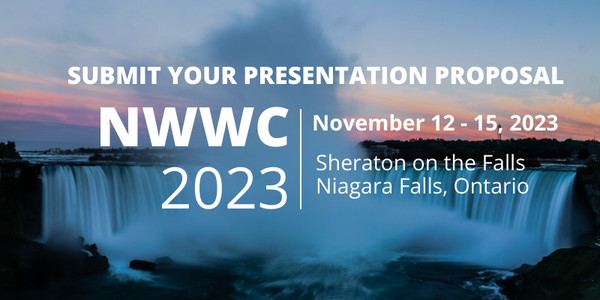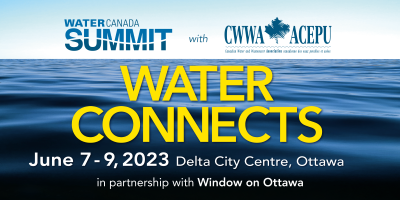 |
||||||||||||||
| Subscribe | Past Issues | www.cwwa.ca | Water Source Magazine | ||||||||||||||
|
CWWA News
Do you think of natural infrastructure at all? How well do you understand the concept? Is your utility doing anything in this area? What are the challenges you face? These are the simple questions we are asking Canadian water leaders in our latest national survey. Would you like to present at THE national conference for Canada’s municipal water utility sector? Share your experience, research or case studies with national leaders on water and wastewater. We're seeking presentations on all aspects of water and wastewater management from drinking water, to wastewater to general utility management challenges.
Federal Initiatives
New amendments aligning the Hazardous Products Regulations with the seventh revised edition of the United Nations Globally Harmonized System of Classification and Labelling of Chemicals (GHS) will require companies to make further investments in revising WHMIS/GIS labels, safety data sheets and A maximum acceptable concentration (MAC) of 0.006 mg/L (6 μg/L) is proposed for antimony in drinking water. Antimony enters the environment from natural sources and human activities, with coal combustion, mining and smelting being the most important sources of release from human activities. Antimony may enter drinking water from plumbing solders in drinking water distribution systems. Other sources include food, (including breast milk for infants), and beverages. Canadian data indicate that antimony is not commonly found in drinking water. The detection frequency for antimony in drinking water is very low and reported levels are largely below detection limits. The proposed guidelines are protective against health effects from exposure to antimony in drinking water over a lifetime. Any exceedance of the proposed MAC should be investigated and followed by the appropriate corrective actions, if required. The intent of this document is to provide responsible authorities, such as municipalities and water suppliers, with guidance on assessing corrosion and implementing corrosion control measures for distribution systems in residential settings to minimize exposure to lead. It also provides sampling protocols and corrective measures for multi-dwelling buildings, schools, daycare facilities and office buildings, for those authorities, such as school boards, building owners or employers, that are responsible for the health and safety of the occupants of such buildings. This document outlines the steps that should be taken to reduce population exposure to lead, which may also reduce the consumer’s exposure to other corrosion-related contaminants, such as copper. Concerns related to other contaminants whose concentrations may be affected by corrosion, such as iron, are also briefly discussed. CWWA has been anticipating these revisions, as they will align federal corrosion control guidance with the Guidelines for Lead in Drinking Water. The Committee is reviewing the draft, and will submit comments. Mark your calendars for June 7 – June 9, 2023 and join us at the Delta City Centre Hotel in Ottawa! CWWA is excited to be joining with Water Canada to host our Window on Ottawa as part of the Water Canada Summit. This event will have all the federal/national program and legislative updates our members expect from the Window on Ottawa, but this collaboration will also allow a deeper exploration of the issues impacting the Canadian water landscape Provincial News
As part of More Homes Built Faster Act, 2022, a new Minister’s regulation will require conservation authorities to include fee provisions in cost apportioning agreements with municipalities and to identify lands suitable for housing or housing infrastructure in their land inventories. Effective January 1, 2023, the following provisions were brought into force:
On December 21, 2022, the Manitoba government announced the launch of online public engagement to seek input for the first water strategy action plan under the new water management strategy. The strategy, which was launched on November 2, 2022, has two components. The first is the water management strategy framework, which provides high-level direction and guidance on water. The second component of the strategy is a water action plan, intended to be a guide to specific and time-bound actions that the Manitoba government will take to implement the framework. The first water strategy action plan is expected for release in spring 2023. Snippings & Clippings
Wastewater Digest Utilities should engage with federal funding agencies now to understand how the Buy America requirements will affect shovel-ready and future projects. Water Canada Inflow and infiltration (I&I) happens when groundwater, stormwater or snowmelt enter the sanitary sewage system through sump pumps, downspouts, foundation drains and/or holes and cracks in pipes, which can lead to basement flooding, less efficient sewage treatment, overflows into the environment and reduced life expectancy of infrastructure. With increasing severity and frequency of rainfall events due to climate change, the negative impacts of I&I are more keenly felt by municipalities, pushing them to develop strategies to meet the increasing risks. Bloomberg 3M Co., confronting regulatory pressure and lawsuits that threaten billions of dollars in damages, will stop making so-called forever chemicals and aim to discontinue their use in products by the end of 2025. ES&E Magazine Without further adaptation to climate change, a new report warns that more extreme rainfall in Ontario could add $6.2 billion to the costs of maintaining storm and wastewater infrastructure by 2030. ES&E Magazine Some 35,000 water customers in the Quebec Village of Gatineau were recently under a boil water advisory due to a depressurization issue at the local water plant, just one week after a similar situation left millions of customers under a boil advisory in Houston, Texas. Globe and Mail Nothing about Arizona’s Harquahala Valley looks like an oasis. Saguaro cactuses, the icon of the state, dot its scrubby expanses. Great billows of dust follow vehicles that travel its dirt roads. It averages 127 millimetres of rain a year, making it among the driest places in the U.S. |
||||||||||||||



